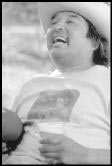SKINS
directed by Chris Eyre
opens Sept. 27 at Harvard Exit
HERE’S A FIRST: Kitchen sink drama where no one can afford the kitchen or the sink. Based on a 1995 novel by Oglala Sioux writer Adrian C. Louis, Skins is a wrenching tale of poverty, family dysfunction, and alcoholism on South Dakota’s Pine Ridge Indian Reservation—perhaps the most miserable place in the United States, where most everyone lives welfare check to welfare check and blows it all on beer. It’s also a place badly in need of Sherman Alexie’s nimble wit and his debunking of grim Native American stereotypes that distinguished director Chris Eyre’s first feature, 1998’s Smoke Signals. Instead, working for hire for a white producer and screenwriter, Eyre offers up an earnest stew of pathology and despair. Though the novel is from the ’90s, the film seems stuck in the Wounded Knee-era ’70s.
Rudy (Eric Schweig) is a do-gooder cop palpably disgusted by his own people, especially his alcoholic older brother, Mogie (Graham Greene), a pants-wetting drunk with zero self-respect. (When beer is splashed on his Madonna T-shirt, he sputters in alarm, “I love this woman!”) Mogie represents everything that’s wrong on the rez, which enrages Rudy to the point of undertaking nighttime vigilantism—with predictably disastrous results.
The love-hate kinship between the straight arrow and the black sheep is a hoary dramatic clich鬠and Skins doesn’t help itself with clumsy plotting. Brotherly confrontation scenes merely repeat themselves. Minor characters come and go without reason or definition. Music swells to amplify obvious emotion. Flashbacks patly illustrate the brothers’ dysfunctional family history. The movie has its raw power, but that force seems like it’s been extracted only from the novel’s emotional high points, with the connective tissue missing.
Yet for all its ham-fisted limitations, Skins reveals a kind of Great Plains ghetto that’s stark and surprising. As in a documentary, some of its finest moments aren’t scripted at all. Shooting on location, Eyre simply trains his camera on the dusty yards, mobile homes, feral dogs, idle children, broken-down cars, and general squalor. Then he points it at the grand surrounding American landscape—the Native American landscape, that which they once owned—and you understand what Mogie’s drinking to forget.
A few white faces are glimpsed across the border in Nebraska where Indians buy beer (the rez is dry), but Skins‘ anger is mainly self-directed. Eyre achieves his most horrifying effect by depicting the blas頌akotas who maim and kill a harmless drunken house burglar in a bear trap. They’re past caring if it’s wrong, which drives lawman Rudy further into despair.
Skins ends with Rudy’s supposedly triumphant act of defiance on nearby Mount Rushmore. There is the hopeful sense that he’s finally letting go of his rage. Yet the movie leaves no doubt that the grip of history and alcohol will not release so easily.









